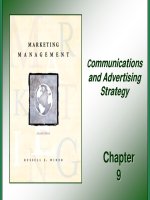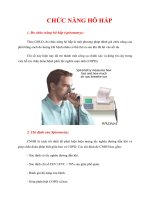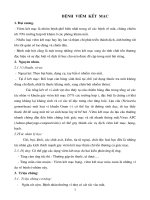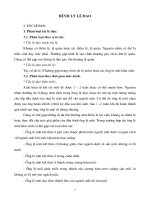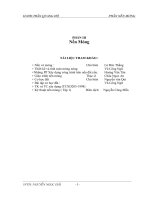Tài liệu Giáo trình: Marketing Management_ Chapter 02 doc
Bạn đang xem bản rút gọn của tài liệu. Xem và tải ngay bản đầy đủ của tài liệu tại đây (1.01 MB, 38 trang )
2 - 1
Chapter
Chapter
2
2
A Strategic
A Strategic
Marketing
Marketing
Framework
Framework
2 - 2
Key Learning Points
Key Learning Points
Elements of a complete marketing
Elements of a complete marketing
strategy
strategy
Developing a value proposition
Developing a value proposition
Developing competitive advantage
Developing competitive advantage
Positioning products and services
Positioning products and services
The product life cycle and how it
The product life cycle and how it
affects marketing strategies
affects marketing strategies
2 - 3
Figure 2-1:
A Complete
Marketing Strategy
2 - 4
Marketing Strategy
Marketing Strategy
Objectives
Objectives
–
–
Mission statements describe the
Mission statements describe the
customer orientation or business
customer orientation or business
philosophy
philosophy
–
–
Corporate objectives state the
Corporate objectives state the
overall goals to be achieved in
overall goals to be achieved in
financial terms
financial terms
2 - 5
Marketing Strategy
Marketing Strategy
Characteristics of well
Characteristics of well
-
-
written
written
objectives:
objectives:
–
–
Lists a quantified standard of
Lists a quantified standard of
performance
performance
–
–
Designates a clear time frame
Designates a clear time frame
–
–
States goal in measurable terms
States goal in measurable terms
–
–
Should be challenging but realistic
Should be challenging but realistic
2 - 6
Marketing Strategy
Marketing Strategy
Customer and competitor targets
Customer and competitor targets
–
–
Which customer
Which customer
groups should
groups should
be targeted?
be targeted?
•
•
Begin by
Begin by
considering
considering
the strategic
the strategic
alternatives outlined in Figure 2.2
alternatives outlined in Figure 2.2
2 - 7
Figure 2-2:
Strategic Alternatives
2 - 8
Marketing Strategy
Marketing Strategy
Market
Market
Penetration
Penetration
Market
Market
Development
Development
Targeting the
Targeting the
company
company
’
’
s own
s own
customers
customers
–
–
Should be a high priority
Should be a high priority
Targeting competitor
Targeting competitor
’
’
s
s
customers
customers
–
–
Riskier and more
Riskier and more
expensive strategy
expensive strategy
–
–
Common in slow growth
Common in slow growth
markets
markets
–
–
Price promotions are key
Price promotions are key
Key Strategies
Key Strategies
2 - 9
Marketing Strategy
Marketing Strategy
Market
Market
Penetration
Penetration
Market
Market
Development
Development
Targeting
Targeting
nonbuying
nonbuying
customers in currently
customers in currently
targeted segments
targeted segments
–
–
Is it profitable?
Is it profitable?
Targeting new
Targeting new
customers in new
customers in new
segments
segments
–
–
Will it require the
Will it require the
introduction of new or
introduction of new or
modified products?
modified products?
Key Strategies
Key Strategies
2 - 10
Marketing Strategy
Marketing Strategy
Market Development Strategies:
Market Development Strategies:
Entering Foreign Markets
Entering Foreign Markets
–
–
Requires decisions related to:
Requires decisions related to:
•
•
The choice of country or countries to enter
The choice of country or countries to enter
•
•
The timing of the entry
The timing of the entry
•
•
How to operate in the chosen countries
How to operate in the chosen countries
–
–
Five factors should be considered when
Five factors should be considered when
deciding how to enter a foreign market
deciding how to enter a foreign market
2 - 11
2 - 12
Marketing Strategy
Marketing Strategy
Product Features
Product Features
–
–
After formulating
After formulating
objectives and
objectives and
determining
determining
customer and
customer and
competitor
competitor
targets, the next
targets, the next
key decision is to
key decision is to
select the specific
select the specific
features to include
features to include
in the product.
in the product.
2 - 13
Marketing Strategy
Marketing Strategy
Product Features
Product Features
–
–
Different features are often used to
Different features are often used to
attract different segments.
attract different segments.
–
–
Features may be product
Features may be product
-
-
specific or
specific or
package
package
-
-
related.
related.
–
–
Creating several versions of a
Creating several versions of a
manufactured good can be very
manufactured good can be very
expensive.
expensive.
–
–
Services and information packages are
Services and information packages are
more easily tailored.
more easily tailored.
2 - 14
Can you think of a current
Can you think of a current
product that could appeal to a
product that could appeal to a
different market segment if the
different market segment if the
packaging were changed
packaging were changed
in some fashion? Explain.
in some fashion? Explain.
Discussion Question
Ketchup, margarine, and even
Ketchup, margarine, and even
peanut butter have successfully
peanut butter have successfully
used packaging innovations,
used packaging innovations,
such as the squeeze container,
such as the squeeze container,
to appeal to new markets.
to appeal to new markets.
2 - 15
Marketing Strategy
Marketing Strategy
The Value
The Value
Proposition
Proposition
Differentiation
Differentiation
Product
Product
Positioning
Positioning
Core Strategy
Core Strategy
2 - 16
Marketing Strategy
Marketing Strategy
The Value
The Value
Proposition
Proposition
Differentiation
Differentiation
Product
Product
Positioning
Positioning
Summarizes into a
Summarizes into a
single paragraph:
single paragraph:
–
–
The customer
The customer
–
–
The competitive
The competitive
targets
targets
–
–
The customer
The customer
’
’
s
s
reason for buying
reason for buying
your brand
your brand
Forms the basis for
Forms the basis for
the marketing mix
the marketing mix
Core Strategy
Core Strategy
2 - 17
Product & Service
Product & Service
Decisions
Decisions
Value Proposition
Value Proposition
For
For
(target segment n),
(target segment n),
the
the
(product/brand name)
(product/brand name)
is a
is a
(product category)
(product category)
that
that
unlike
unlike
(competitor targets),
(competitor targets),
(statement of primary
(statement of primary
differentiation).
differentiation).
2 - 17
2 - 18
Marketing Strategy
Marketing Strategy
The Value
The Value
Proposition
Proposition
Differentiation
Differentiation
Product
Product
Positioning
Positioning
Competitive
Competitive
advantages (CA)
advantages (CA)
should have three
should have three
characteristics:
characteristics:
–
–
CA should generate
CA should generate
customer value
customer value
–
–
Increased value must
Increased value must
be perceived by the
be perceived by the
consumer
consumer
–
–
CA should be difficult
CA should be difficult
to copy
to copy
Core Strategy
Core Strategy
2 - 19
Product & Service
Product & Service
Decisions
Decisions
Key Decisions
Key Decisions
Marketing Strategy
Marketing Strategy
General Approaches to
General Approaches to
Creating Competitive Advantage
Creating Competitive Advantage
Cost
Cost
-
-
or price
or price
-
-
based advantage
based advantage
Quality
Quality
-
-
based or differentiation
based or differentiation
advantage
advantage
Perceived quality or brand
Perceived quality or brand
-
-
based advantage
based advantage
2 - 19
2 - 20
Marketing Strategy
Marketing Strategy
Cost
Cost
-
-
or Price
or Price
-
-
Based Advantage
Based Advantage
–
–
Difficult to achieve
Difficult to achieve
–
–
Two primary methods of creating a
Two primary methods of creating a
cost
cost
-
-
or price
or price
-
-
based advantage:
based advantage:
•
•
Being the largest producer and benefiting
Being the largest producer and benefiting
from economies of scale
from economies of scale
•
•
Taking advantage of the experience curve
Taking advantage of the experience curve
–
–
Strict cost control can also help smaller
Strict cost control can also help smaller
firms or those with less experience to
firms or those with less experience to
develop a cost
develop a cost
-
-
based advantage
based advantage
2 - 21
Figure 2-4:
Learning Curves for
Software and Hardware
2 - 22
Marketing Strategy
Marketing Strategy
Quality
Quality
-
-
Based Differentiation
Based Differentiation
–
–
Development of an observable
Development of an observable
difference that is valued by
difference that is valued by
customers
customers
•
•
Typically implies higher costs
Typically implies higher costs
•
•
Allows for both higher prices and
Allows for both higher prices and
higher margins
higher margins
–
–
Differentiation can occur at any
Differentiation can occur at any
point within the value chain
point within the value chain
2 - 23
Product & Service
Product & Service
Decisions
Decisions
Key Decisions
Key Decisions
Marketing Strategy
Marketing Strategy
Differentiation Opportunities
Differentiation Opportunities
within the Value Chain
within the Value Chain
Inbound
Inbound
Logistics
Logistics
Operational
Operational
Advantages
Advantages
2 - 23
Outbound
Outbound
Logistics
Logistics
Marketing
Marketing
and Sales
and Sales
Service
Service
2 - 24
Marketing Strategy
Marketing Strategy
Perceived Quality or Brand
Perceived Quality or Brand
-
-
Based
Based
Differentiation
Differentiation
–
–
Perceptual product differences are often used
Perceptual product differences are often used
for differentiation when actual differences are
for differentiation when actual differences are
small, hard to achieve, or difficult to sustain
small, hard to achieve, or difficult to sustain
–
–
Price, distribution, and marketing
Price, distribution, and marketing
communications can all contribute to brand
communications can all contribute to brand
-
-
based differentiation
based differentiation
–
–
Thorough understanding of consumers
Thorough understanding of consumers
’
’
perception of your brand compared to
perception of your brand compared to
competitors is required
competitors is required
•
•
Perceptual maps are a useful tool
Perceptual maps are a useful tool
2 - 25
Figure 2-5:
Perceptual Map:
Retail Banking

